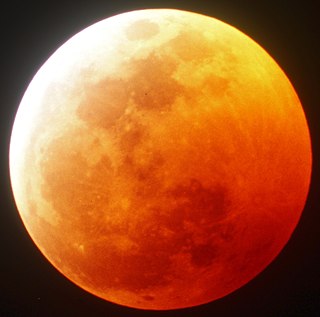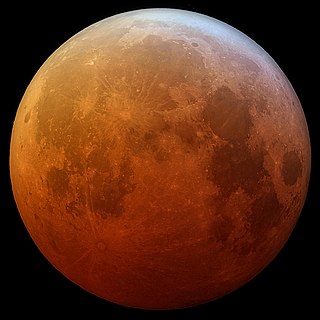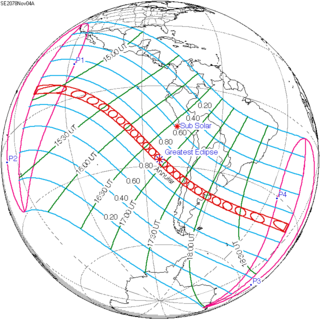| Penumbral eclipse | |||||||||
| Date | 20 January 1981 | ||||||||
|---|---|---|---|---|---|---|---|---|---|
| Gamma | −1.0141 | ||||||||
| Magnitude | 1.0136 | ||||||||
| Saros cycle | 114 (57 of 71) | ||||||||
| Penumbral | 263 minutes, 50 seconds | ||||||||
| |||||||||
A penumbral lunar eclipse took place on Tuesday, January 20, 1981, the first of two lunar eclipses in 1981. In a rare total penumbral eclipse, the entire Moon was partially shaded by the Earth (though none of it was in complete shadow), and the shading across the Moon should have been quite visible at maximum eclipse. The penumbral phase lasted for 4 hours and 24 minutes in all, though for most of it, the eclipse was extremely difficult, if not impossible to see. The moon's apparent diameter was larger because the eclipse occurred 5.2 days after perigee (Perigee on approximately 1981 Jan 15 at 03:01:56.7 UTC). [1]
This was a relatively rare total penumbral lunar eclipse with the moon passing entirely within the penumbral shadow without entering the darker umbral shadow. [2]
Penumbral Magnitude = 1.01360
Umbral Magnitude = -0.01916
Gamma = -1.01421
Sun Right Ascension = 20.16
Sun Declination = -20.1
Sun Diameter: 1950.4 arc-seconds (32'30.4")
Moon Right Ascension = 8.15
Moon Declination = 19.1
Moon Diameter = 1888.6 arc-seconds (31'28.6")
Earth's Shadow Right Ascension: 8.16
Earth's Shadow Declination: 20.1
Earth's Shadow Diameter: 8,968.32 arc-seconds (2.4912 degrees)
Greatest Eclipse: Tuesday, 20 January 1981 at 07:49:56.7 UTC
Saros Series = 114th (57 of 71)
| Lunar eclipse series sets from 1980–1984 | ||||||||
|---|---|---|---|---|---|---|---|---|
| Descending node | Ascending node | |||||||
| Saros | Date Viewing | Type Chart | Gamma | Saros | Date Viewing | Type Chart | Gamma | |
| 109 | 1980 Jul 27  | Penumbral | 1.41391 | 114 | 1981 Jan 20  | Penumbral | −1.01421 | |
| 119 | 1981 Jul 17  | Partial | 0.70454 | 124 | 1982 Jan 09  | Total | −0.29158 | |
| 129 | 1982 Jul 06  | Total | −0.05792 | 134 | 1982 Dec 30  | Total | 0.37579 | |
| 139 | 1983 Jun 25  | Partial | −0.81520 | 144 | 1983 Dec 20  | Penumbral | 1.07468 | |
| 149 | 1984 Jun 13  | Penumbral | −1.52403 | |||||
| Last set | 1980 Aug 26 | Last set | 1980 Mar 13 | |||||
| Next set | 1984 May 15 | Next set | 1984 Nov 08 | |||||
Lunar Saros series 114, repeating every 18 years and 11 days, has a total of 71 lunar eclipse events including 13 total lunar eclipses.
First Penumbral Lunar Eclipse: 0971 May 13
First Partial Lunar Eclipse: 1115 Aug 07
First Total Lunar Eclipse: 1458 Feb 28
First Central Lunar Eclipse: 1530 Apr 12
Greatest Eclipse of Lunar Saros 114: 1584 May 24
Last Central Lunar Eclipse: 1638 Jun 26
Last Total Lunar Eclipse: 1674 Jul 17
Last Partial Lunar Eclipse: 1890 Nov 26
Last Penumbral Lunar Eclipse: 2233 Jun 22
A lunar eclipse will be preceded and followed by solar eclipses by 9 years and 5.5 days (a half saros). [3] This lunar eclipse is related to two annular solar eclipses of Solar Saros 121.
| January 16, 1972 | January 26, 1990 |
|---|---|
 |  |

A total lunar eclipse took place on 3 March 2007, the first of two eclipses in 2007. The Moon entered the penumbral shadow at 20:18 UTC, and the umbral shadow at 21:30 UTC. The total phase lasted between 22:44 UTC and 23:58 UTC with a distinctive brick-red shade. The Moon left the umbra shadow at 01:11 UTC and left the penumbra shadow at 02:24 UTC 2007-03-04. The second lunar eclipse of 2007 occurred on 28 August.

A total lunar eclipse occurred on February 20 and February 21, 2008. It was visible in the eastern evening sky on February 20 for all of North and South America, and on February 21 in the predawn western sky from most of Africa and Europe. Greatest Eclipse occurring on Thursday, February 21, 2008, at 03:26:03 UTC, totality lasting 49 minutes and 45.6 seconds.

A partial lunar eclipse took place on 7 September 2006, the second of two lunar eclipses in 2006. The tables below contain detailed predictions and additional information on the partial lunar eclipse of 7 September 2006.

A total lunar eclipse took place on Tuesday 9 January 2001, the first of three lunar eclipses in 2001. A shallow total eclipse saw the Moon in relative darkness for 1 hour 1 minute and 2 seconds. The Moon was 18.89% of its diameter into the Earth's umbral shadow, and totality was observed in all of Europe, Africa, and Asia. The partial eclipse lasted for 3 hours 16 minutes and 19 seconds and was visible in parts of north-eastern North America and Australia. It is the only total eclipse of 2001. It was visible over Asia and Western Australia with the Middle East getting mid eclipse at midnight.

A total lunar eclipse took place at the Moon's descending node of the orbit on Tuesday, September 16, 1997, the second of two lunar eclipses in 1997. A shallow total eclipse saw the Moon in relative darkness for 1 hour, 1 minute and 30.8 seconds. The Moon was 19.094% of its diameter into the Earth's umbral shadow, and should have been significantly darkened. The partial eclipse lasted for 3 hours, 16 minutes and 28.2 seconds in total. The penumbral eclipse lasted for 5 hours, 8 minutes and 20.1 seconds. The partial eclipse lasted for 3 hours, 16 minutes and 28.2 seconds. The total eclipse lasted for 1 hour, 1 minute and 30.8 seconds. Maximum eclipse was at 18:46:39.1 UTC. The moon's apparent diameter was extremely large because occurred only 3 hours and 21 minutes past perigee. The Moon was only 356,986 km of the Earth at greatest eclipse.

A total lunar eclipse will take place on July 7, 2047. It will last 1 hour 40 minutes and 49 seconds and will plunge the full Moon into deep darkness, as it passes right through the centre of the Earth's umbral shadow. While the visual effect of a total eclipse is variable, the Moon may be stained a deep orange or red colour at maximum eclipse. This will be a great spectacle for everyone who sees it. The partial eclipse will last for 3 hours and 39 minutes in total.
A total lunar eclipse took place on Saturday, May 24 and Sunday, May 25, 1975, the first of two total lunar eclipses in 1975. The Moon was plunged into darkness for 1 hour and 28 minutes in a deep total eclipse which saw the Moon 43% of its diameter inside the Earth's umbral shadow. The visual effect of an eclipse depends on the state of the Earth's atmosphere, but the Moon may have been stained a deep red colour. The partial eclipse lasted for 3 hours and 35 minutes in total. Occurring only 4.4 days after perigee, the Moon's apparent diameter was 0.7% larger than average. The moon was 377,010 km from the Earth at greatest eclipse.
A penumbral lunar eclipse took place on Thursday, March 3, 1988, the first of two lunar eclipses in 1988, the second being on August 27, 1988. Earlier sources compute this as a 0.3% partial eclipse lasting under 14 minutes, and newest calculations list it as a penumbral eclipse that never enters the umbral shadow. In a rare total penumbral eclipse, the entire Moon was partially shaded by the Earth, and the shading across the Moon should have been quite visible at maximum eclipse. The penumbral phase lasted for 4 hours, 53 minutes and 50.6 seconds in all, though for most of it, the eclipse was extremely difficult or impossible to see. The Moon was 2.2 days after apogee, making it 6.1% smaller than average.
A penumbral lunar eclipse took place on Wednesday, October 7, 1987, the second of two lunar eclipses in 1987, the first being on April 14, 1987. The Moon approached within 0.00949% of its diameter outside of touching the Earth’s umbral shadow at maximum eclipse; 98.63% of the Moon's disc was partially shaded by the Earth, with the overall eclipse lasting 4 hours and 14 minutes. While less dramatic than a partial eclipse, a shading across the Moon should have been readily visible to observers. The Moon was just 3.1 days after perigee, making it 2.1% larger than average.
A total lunar eclipse took place on Friday, November 29, 1974, the second of two lunar eclipses in 1974. The Moon was plunged into darkness for 1 hour, 15 minutes and 45 seconds, in a deep total eclipse which saw the Moon 28.961% of its diameter inside the Earth's umbral shadow. The visual effect of this depends on the state of the Earth's atmosphere, but the Moon may have been stained a deep red colour. The partial eclipse lasted for 3 hours, 28 minutes and 58.7 seconds in total. The penumbral eclipse lasted for 5 hours, 33 minutes and 11.6 seconds. The partial eclipse lasted for 3 hours, 28 minutes and 58.7 seconds. The total eclipse lasted for 1 hour, 15 minutes and 45 seconds. Occurring only 3.6 days before perigee, the Moon's apparent diameter was 1.4% larger than average.

A total lunar eclipse occurred on 21 January 2019 UTC. For observers in the Americas, the eclipse took place between the evening of Sunday, 20 January and the early morning hours of Monday, 21 January. For observers in Europe and Africa, the eclipse occurred during the morning of 21 January. The Moon was near its perigee on 21 January and as such can be described as a "supermoon".
A penumbral lunar eclipse took place at the Moon's descending node of the orbit on Tuesday, August 26, 1980, the last of three penumbral lunar eclipses in 1980 with a penumbral magnitude of 0.70891. This subtle penumbral eclipse may have been visible to a skilled observer at maximum eclipse. 70.891% of the Moon's disc was partially shaded by the Earth, which caused a gentle shadow gradient across its disc at maximum; the eclipse as a whole lasted 3 hours, 34 minutes and 26 seconds.

A total lunar eclipse took place on Saturday, April 13, 1968, the first of two total eclipses in 1968, the second being on October 6, 1968.
A partial lunar eclipse took place on Monday, August 17, 1970, the second of two lunar eclipses in 1970, the first was on February 21 of that year. The Earth's shadow on the Moon was clearly visible in this eclipse, with 41% of the Moon in shadow; the partial eclipse lasted for 2 hours and 11 minutes. It was the second of two lunar eclipses in 1970.

A total lunar eclipse took place on Monday, April 24, 1967, the first of two total lunar eclipses in 1967, the second being on October 18, 1967.

A total lunar eclipse will take place on October 30, 2050.

An annular solar eclipse occurred on December 14, 1955. A solar eclipse occurs when the Moon passes between Earth and the Sun, thereby totally or partly obscuring the image of the Sun for a viewer on Earth. An annular solar eclipse occurs when the Moon's apparent diameter is smaller than the Sun's, blocking most of the Sun's light and causing the Sun to look like an annulus (ring). An annular eclipse appears as a partial eclipse over a region of the Earth thousands of kilometres wide.

An annular solar eclipse occurred at the Moon's descending node of the orbit on February 4–5, 1981. A solar eclipse occurs when the Moon passes between Earth and the Sun, thereby totally or partly obscuring the image of the Sun for a viewer on Earth. An annular solar eclipse occurs when the Moon's apparent diameter is smaller than the Sun's, blocking most of the Sun's light and causing the Sun to look like an annulus (ring). An annular eclipse appears as a partial eclipse over a region of the Earth thousands of kilometres wide. This annular solar eclipse was large because the Moon covered 99.4% of the Sun, with a path width of only 25 km . It was visible in Australia, crossing over Tasmania and southern Stewart Island of New Zealand near sunrise on February 5 (Thursday), and ended at sunset over western South America on February 4 (Wednesday). Occurring only 4 days before perigee, the moon's apparent diameter was larger.

An annular solar eclipse will occur on Friday, November 4, 2078. A solar eclipse occurs when the Moon passes between Earth and the Sun, thereby totally or partly obscuring the image of the Sun for a viewer on Earth. An annular solar eclipse occurs when the Moon's apparent diameter is smaller than the Sun's, blocking most of the Sun's light and causing the Sun to look like an annulus (ring). An annular eclipse appears as a partial eclipse over a region of the Earth thousands of kilometres wide. The path of annularity will cross Pacific Ocean, South America, and Atlantic Ocean. The tables below contain detailed predictions and additional information on the Annular Solar Eclipse of 4 November 2078.

A total lunar eclipse took place at the Moon's descending node of the orbit on Monday, November 7, 1938, the second of two lunar eclipses in 1938, with an umbral eclipse magnitude of 1.35251. It was visible in the Americas, Europe, Asia, Asia and west in Oceania. The Moon was plunged into darkness for 1 hour, 21 minutes and 25.9 seconds, in a deep total eclipse which saw the Moon 35.251% of its diameter inside the Earth's umbral shadow. The visual effect of this depends on the state of the Earth's atmosphere, but the Moon may have been stained a deep red colour. The partial eclipse lasted for 3 hours, 30 minutes and 12.5 seconds in total. Occurring only 3.2 days before perigee, the Moon's apparent diameter was 2% larger than average.